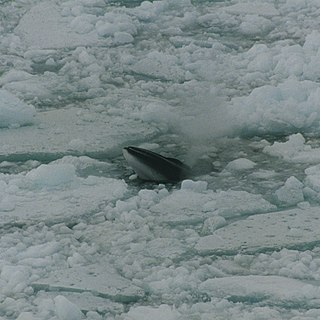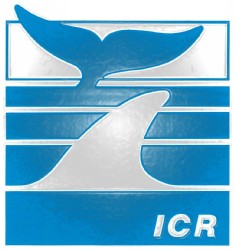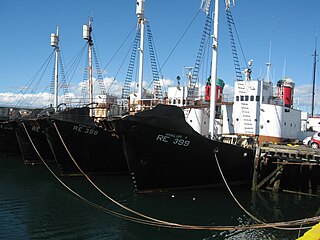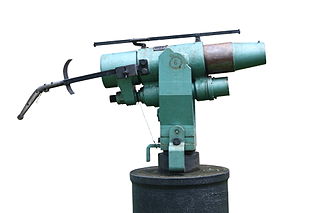
Whaling is the hunting of whales for their usable products such as meat and blubber, which can be turned into a type of oil that was important in the Industrial Revolution. Whaling was practiced as an organized industry as early as 875 AD. By the 16th century, it had become the principal industry in the Basque coastal regions of Spain and France. The whaling industry spread throughout the world and became very profitable in terms of trade and resources. Some regions of the world's oceans, along the animals' migration routes, had a particularly dense whale population and became targets for large concentrations of whaling ships, and the industry continued to grow well into the 20th century. The depletion of some whale species to near extinction led to the banning of whaling in many countries by 1969 and to an international cessation of whaling as an industry in the late 1980s.

Rorquals are the largest group of baleen whales, comprising the family Balaenopteridae, which contains nine extant species in two genera. They include the largest known animal that has ever lived, the blue whale, which can reach 180 tonnes, and the fin whale, which reaches 120 tonnes ; even the smallest of the group, the northern minke whale, reaches 9 tonnes.

Baleen whales, also known as whalebone whales, are marine mammals of the parvorder Mysticeti in the infraorder Cetacea, which use keratinaceous baleen plates in their mouths to sieve planktonic creatures from the water. Mysticeti comprises the families Balaenidae, Balaenopteridae (rorquals), Eschrichtiidae and Cetotheriidae. There are currently 16 species of baleen whales. While cetaceans were historically thought to have descended from mesonychians, molecular evidence instead supports them as a clade of even-toed ungulates (Artiodactyla). Baleen whales split from toothed whales (Odontoceti) around 34 million years ago.

The minke whale, or lesser rorqual, is a species complex of baleen whale. The two species of minke whale are the common minke whale and the Antarctic minke whale. The minke whale was first described by the Danish naturalist Otto Fabricius in 1780, who assumed it must be an already known species and assigned his specimen to Balaena rostrata, a name given to the northern bottlenose whale by Otto Friedrich Müller in 1776. In 1804, Bernard Germain de Lacépède described a juvenile specimen of Balaenoptera acuto-rostrata. The name is a partial translation of Norwegian minkehval, possibly after a Norwegian whaler named Meincke, who mistook a northern minke whale for a blue whale.

The common minke whale or northern minke whale is a species of minke whale within the suborder of baleen whales.

The Antarctic minke whale or southern minke whale is a species of minke whale within the suborder of baleen whales. It is the second smallest rorqual after the common minke whale and the third smallest baleen whale. Although first scientifically described in the mid-19th century, it was not recognized as a distinct species until the 1990s. Once ignored by the whaling industry due to its small size and low oil yield, the Antarctic minke was able to avoid the fate of other baleen whales and maintained a large population into the 21st century, numbering in the hundreds of thousands. Surviving to become the most abundant baleen whale in the world, it is now one of the mainstays of the industry alongside its cosmopolitan counterpart the common minke. It is primarily restricted to the Southern Hemisphere and feeds mainly on euphausiids.

Whale watching is the practice of observing whales and dolphins (cetaceans) in their natural habitat. Whale watching is mostly a recreational activity, but it can also serve scientific and/or educational purposes. A study prepared for International Fund for Animal Welfare in 2009 estimated that 13 million people went whale watching globally in 2008. Whale watching generates $2.1 billion per annum in tourism revenue worldwide, employing around 13,000 workers. The size and rapid growth of the industry has led to complex and continuing debates with the whaling industry about the best use of whales as a natural resource.

The pygmy right whale is a species of baleen whale. It may be a member of the cetotheres, a family of baleen whales which until 2012 were thought to be extinct; C. marginata has otherwise been considered the sole member of the family Neobalaenidae and is the only member of the genus Caperea. First described by John Edward Gray in 1846, it is the smallest of the baleen whales, ranging between 6 and 6.5 metres in length and 3,000 and 3,500 kilograms in mass. Despite its name, the pygmy right whale may have more in common with the gray whale and rorquals than the bowhead and right whales.

Balaenoptera is a genus of rorquals containing eight extant species. Balaenoptera comprises all but two of the extant species in its family ; the genus is currently polyphyletic, with the two aforementioned species being phylogenetically nested within it.

The Institute of Cetacean Research is a Japanese research organization that claims to specialise in "biological and social sciences related to whales" but is widely believed to be a front for commercial whaling.

Japanese whaling, in terms of active hunting of whales, is estimated by the Japan Whaling Association to have begun around the 12th century. However, Japanese whaling on an industrial scale began around the 1890s when Japan started to participate in the modern whaling industry, at that time an industry in which many countries participated.

Whaling in Iceland began with spear-drift hunting as early as the 12th century, and continued in a vestigial form until the late 19th century, when other countries introduced modern commercial practices. Today, Iceland is one of a handful of countries that formally object to an ongoing moratorium established by the International Whaling Commission in 1986, and that still maintain a whaling fleet. One company remains concentrated on hunting fin whales, largely for export to Japan, while the only other one previously hunted minke whales for domestic consumption until 2020, as the meat was popular with tourists. In 2018, Hvalur hf whalers killed a rare blue whale/fin whale hybrid.
Whaling in Norway involves hunting of minke whales for use as animal and human food in Norway and for export to Japan. Whale hunting has been a part of Norwegian coastal culture for centuries, and commercial operations targeting the minke whale have occurred since the early 20th century. Some still continue the practice in the modern day, within annual quotas.
Abiotrophia is a genus of lactic acid bacteria, a family in the phylum Bacillota (Bacteria).

Whale conservation refers to the conservation of whales.

The practice of whaling in South Africa gained momentum at the start of the 19th century and ended in 1975. By the mid-1960s, South Africa had depleted their population of fin whales, and subsequently those of sperm and sei whales, and had to resort to hunting the small and less-profitable minke whale. Minke whales continued to be caught and brought to the Durban whaling station from 1968 until 1975. South Africa comprehensively banned whaling in 1979.
Pennella balaenopterae is a large ectoparasitic copepod specialising in parasitising marine mammals. It is the largest member of the genus Pennella, the other species of which are parasites of larger marine fish.
Bio-duck is a sound recorded in the Southern Ocean, specifically in Antarctic Waters and the West Coast of Australia. It was first reported in 1960 by submarine personnel, who gave the sound its name, associating it with that of a duck. Once dubbed as the “largest still unresolved mysteries of the Southern Ocean”, the origin of the sound remained a mystery for decades until 2014, when it was concluded that the sound originated from Antarctic minke whales.

A harpoon cannon is a whaling implement developed in the late 19th century and most used in the 20th century. It would be mounted on the bow of a whale catcher, where it could be easily aimed with a wide field of view at the target. Powered by black powder and later, smokeless powder, it would generally fire a large steel harpoon, either solid steel or fitted with an exploding black powder, or later, penthrite (PETN) grenade.














